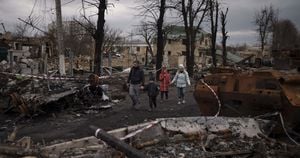Drones are reshaping various aspects of modern life, from surveillance and military operations to search and rescue missions and even photography. Their rapid adoption across multiple sectors marks significant advancements, but also raises complex discussions about ethics, privacy, and utility. This article delves deep, exploring recent developments and applications of drone technology, touching on military, humanitarian, and personal use cases.
To kick things off, the U.S. military has made headlines with its strategic deployment of drones for specific military operations. Recently, U.S. military forces conducted a drone strike in Syria, targeting a Saudi militant linked to al-Qaida. This incident exemplifies how drones are becoming increasingly significant tools for precision strikes, significantly reducing operational risks to ground troops. An anonymous source from the military confirmed the operation, highlighting its importance amid the backdrop of complex regional conflicts.
Meanwhile, the U.S. Navy is ramping up its commitment to unmanned aerial vehicles as well. The USS George H.W. Bush (CVN 77) has recently installed the Unmanned Air Warfare Center (UAWC), designated to control new MQ-25 "Stingray" drones. These advanced unmanned aircraft systems—costing around $136 million each—are engineered to refuel fighter jets mid-air, thereby extending the Navy's operational reach during missions. Captain Daniel Fucito of NAVAIR emphasized how this command center will lay the groundwork for how the Navy will handle not just today's technology but also future advancements, including Collaborative Combat Aircraft.
The UAWC aims to test its operational capabilities at sea starting next year, marking the U.S. Navy's increasing reliance on around-the-clock drone operations. This operational upgrade responds to the changing dynamics of modern warfare, where unmanned systems have come to play pivotal roles, particularly as seen during the recent intensifying engagements between the U.S. Navy and Houthi rebels over the Red Sea.
Now, shifting gears, we also look at the humanitarian side of drone usage. While military applications often dominate discussions, drones have proven especially effective for search and rescue missions. A notable example occurred recently when officials from the Sumner County Emergency Management Agency utilized drones to locate a missing 93-year-old woman suffering from Alzheimer’s. Within minutes of launching the drone equipped with thermal imaging technology, search teams pinpointed her location. Ken Weidner, the Director of the agency, reflected on the mission’s urgency and the effective use of modern technology to save lives, calling it heartening to see such rapid results.
They successfully guided search party members to her precise location, demonstrating how drones significantly increase the likelihood of finding missing persons, especially during precious hours immediately following their disappearance. Given the success of this incident, Sumner County has reportedly utilized drones to locate twelve missing individuals since starting such programs, showcasing the technology's practical applications beyond military and commercial realms.
Switching to the creative domain, drones have also opened up new horizons for photographers and videographers. Renowned pro photographer Jeremy Walker, who admitted to initially despising drones, recently shared his transformation after receiving one as a birthday gift. He acknowledged undergoing the necessary training and finding unexpected joy using drones to gain elevated perspectives, enhancing his photography. It's interesting to note how the sentiment surrounding drones has shifted among enthusiasts. Once viewed as intrusive, they are now seen as tools to create stunning images from angles previously inconceivable without costly helicopter rentals.
Yet, Walker also raised valid points about drone etiquette, highlighting the rude interruptions one may experience when drone operators overlook the spaces others are working or relaxing in. This blend of admiration for the technology and frustration for its misuse captures the nuanced perceptions surrounding drones among those who rely on the peaceful quiet of nature to create.
Exploring the global stage, drone applications extend far beyond the U.S. Recently, Turkey faced scrutiny after its military operations against Kurdish militants led to the deaths of journalists and civilians alike. Turkish drone strikes have become increasingly frequent and controversial, with accusations of excessive force and violations of international laws. Recent incidents have underscored the tension between military objectives and significant human costs, as two Kurdish journalists, Gulistan Tara and Hero Bahadin, tragically lost their lives during such missions. This incident propelled groups like Reporters Without Borders to call for accountability, emphasizing the dangers journalists face amid military actions.
Through these varied lenses of military, rescue, and artistic applications, the versatility and growing prevalence of drone technology are undeniable. Each application sparks discussions about the ethical and legal frameworks surrounding their usage. While the military sees drones as revolutionary tools for surveillance and attack, humanitarian efforts reflect their life-saving potential. Artists find new ways to express creativity through aerial perspectives, raising questions about public space and respect for boundaries.
Looking forward, as drones become integral to addressing various challenges—from natural disasters and public safety incidents to military conflict and creative expression—it is imperative to balance innovation with responsibility. Regulations must evolve to manage drone use effectively, ensuring safety and privacy. Ongoing dialogue among stakeholders—including governments, businesses, and users—will be central to shaping the future of drone operations.
Indeed, the technological evolution of drones exemplifies how modern innovations can address complex issues faced by society today. The continuous integration of advanced features and improved functionalities will only heighten the debates on ethical use, potential regulation, and broader societal effects. It's admittedly exhilarating to think about how the effective, responsible use of drone technology can shape our world as we move forward.
With developments occurring at unprecedented speeds and discussing the importance of ethical frameworks surrounding these technologies, there’s no denying drones are significantly redefining our interactions with the world.



